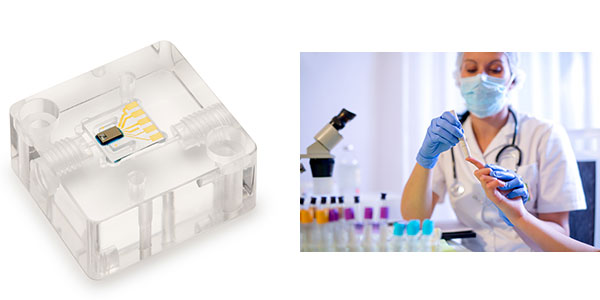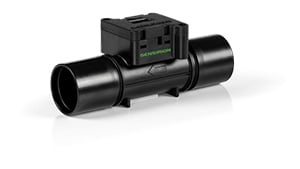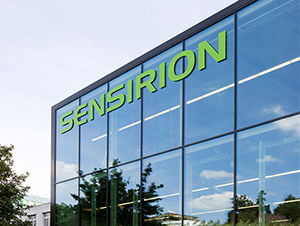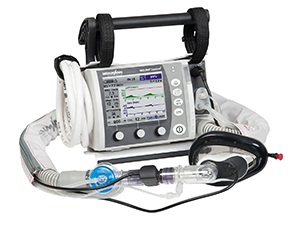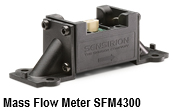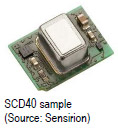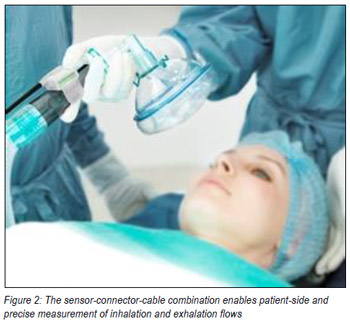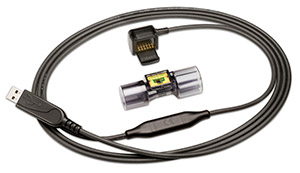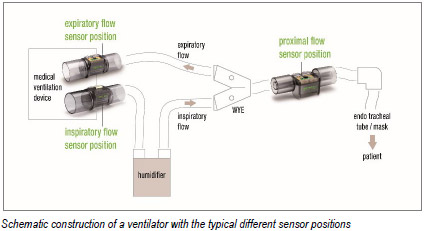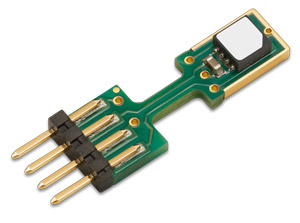The trend towards near-patient lab diagnostics continues
In medical diagnostics, the trend towards near-patient lab diagnostics (point-of-care testing, or POCT) continues apace. The idea is that testing should take place as promptly as possible and ideally directly at the patient’s bedside. For more complex examinations, precise microfluidic systems are required.
One well-known example of a POCT is a urine test using a paper strip. In these tests, the different components of urine – such as red and white blood cells, glucose and the pH value – cause color changes on the reactive surfaces of the test strip. By comparing of the color patterns to a reference scale, the nurse can ascertain qualitative information about the concentration of the various substances in the sampled urine. In an even simpler exemplary procedure, the oxygen saturation of blood can be determined non-invasively through the skin by clipping an optical sensor to the fingertip of the patient. Previously, before the advent of these pulse oximeters, a blood sample had to be taken and sent to the central lab for testing.
More complex tests – for example, to detect certain viruses or bacteria – still depend on the elaborate infrastructure and specialist personnel of a central lab. Such tests often require additional steps in terms of sample preparation or pre-treatment, special temperature conditions or complex devices for analysis. In order to carry out these tests directly at the patients’ bedside in the hospital, the test procedures must be simplified and interaction with the user minimized. In ideal cases, the entire test is conducted independently on a single microfluidic system; i.e. the entire ‘lab’ is integrated on a chip and thus becomes a ‘lab on a chip’.
Microfluidic POCT In recent decades, a great deal of research has been carried out in the field of microfluidics, particularly in the biosciences, with the aim of miniaturizing and automating lab experiments, diagnostic tests and (bio)chemical processes. Instead of pipetting discrete quantities of liquids from one container to another, today the liquid in a microfluidic system flows through the tiny channels of a manifold. The liquid in these channels is generally moved by external pumps or pressure sources to which the fluidic chip is connected. To control the applied pressures or stabilize the flow generated by the pump, the flow rate is measured using flow sensors. Thanks to their outstanding sensitivity even at extremely minimal flow rates, Sensirion’s microthermal mass flow meters for liquids set the industry standard in the precise monitoring of liquid flows in microfluidic systems.
The dimensions of the channels in the fluidic system have been significantly reduced down to the micrometer range, with the liquid volumes in the microliter or even nanoliter range. This enables the microfluidics to drastically reduce the sample and reagent quantities, enable faster reactions and thus increase throughput. And the smaller size of the fluidic system also means lower costs and smaller devices. Both are necessary conditions in order to conduct tests in a decentralized manner directly at the place of care; i.e. at the bedside, on the same hospital floor or in a doctor’s office. This, in turn, simplifies the logistics and provides faster results for better and more targeted treatment of patients.
Possible applications in medical technology and other fields
Commercially available microfluidic POCT devices can be used, for example, to measure proteins used as biomarkers in the diagnosis of heart attacks. Other devices analyze blood samples to determine the composition of red and white blood cells, and their subtypes. Another application in medical technology is cytometry to determine the concentration of T helper cells in monitoring the immune systems of HIV/AIDS patients. Finally, efforts are also under way to transfer molecular-biological methods for the detection of, for example, antibiotic resistant bacteria via their DNA to point-of-care systems. Even genetic fingerprints for forensic purposes can be created using POCT devices.
However, microfluidics play an increasingly important role in areas other than the clinical field, such as research and development and industrial process monitoring. In particular, microbiology is absolutely critical today in the food and drinks production sector; it is used to monitor the quality of yeast cells that ferment malt to beer, and the bacterial populations in milk, which must not exceed certain threshold values. Hitherto, discrete samples have been diverted from the production process and sent to laboratories for testing; now new types of miniaturized flow cytometers enable direct verification of individual production lots or even continuous monitoring on the production line.
Improved performance through precise flow monitoring
Owing to its origins, the field of microfluidics is closely associated with the biosciences and related technologies, such as cell sorting, cell manipulation and DNA analysis. Microfluidics is also relevant in other miniaturized systems that use liquids; for example, microscopic chemical reactors and micro fuel cells for portable energy generation.
In all these emerging application areas, the precise monitoring and control of liquid flows is crucial to the reliable operation of the respective device. With a tiny form factor of just 10 x 10 mm2, Sensirion’s LPG10 flow sensor offers outstanding accuracy and speed in the measurement of extremely low flow rates. The sensor consists of a planar microfluidic glass substrate and enables extremely compact integration in any fluidic system. The proven microthermal measurement method in an innovative design enables flow measurements of just a few milliliters down to single microliters per minute, or even lower. Glass as the only wetted material guarantees optimal compatibility with biological and pharmaceutical processes. The sensor provides a direct and highly precise measurement of the flow rate at every relevant point in the fluidic system. The reliable detection of common errors, such as clogging, air bubbles or leaks, is incorporated of course.
More information
Measuring principle of a microthermal CMOSens® flow sensor
CMOSens® Technology integrates an extremely fast, miniaturized thermal sensor together with the complete high-precision evaluation circuit on a single CMOS microchip. A heating element on the microchip applies a minimal amount of heat to the medium for thermal flow measurement. Two temperature sensors, positioned symmetrically above and below the heat source, detect very small temperature differences with extreme sensitivity and thus provide the fundamental information on heat dispersion, which is directly correlated to the flow rate. Integration of the technology on a single chip ensures that the sensitive, analog sensor signals are amplified, digitized and further processed without interference and with the highest precision, enabling the chip to provide the user with a calibrated and linearized signal via a digital interface.
LPG10 miniature flow sensor
The LPG10 miniature flow sensor integrates a digital CMOSens® technology microsensor on a 10 x 10 mm2 microfluidic chip, making it the world’s smallest fully calibrated digital flow sensor. Downmount connections enable extremely compact integration in fluidic systems.
About Sensirion
Sensirion is the leading manufacturer of high-quality sensors and sensor solutions for the measurement and control of liquid and gas flows, humidity, and temperature. Founded in 1998, the company is based in Staefa near Zurich, Switzerland, and employs people in countries such as the USA, South Korea, Japan, China, Taiwan, and Germany. The headquarters in Switzerland is responsible for research, development, and production.
Millions of Sensirion's sensor components and solutions are used all over the world, including in the medical technology and automotive industry, and in building technology. Sensirion's success is based on the innovative CMOSens® Technology, which combines the sensor and analysis electronics in a single semiconductor chip. This means large unit numbers can be produced at high quality and low cost.


